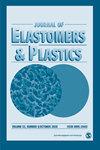Dynamic Vulcanization of HDPE/EVA Blend Using Silane
IF 1.6
4区 材料科学
Q4 MATERIALS SCIENCE, MULTIDISCIPLINARY
引用次数: 13
Abstract
Dynamic vulcanization of high-density polyethylene and ethylene vinyl acetate (HDPE/EVA) blends (50/50 wt%) in the mixing chamber of a torque rheometer was investigated. EVA was selectively cross-linked within the HDPE phase by transesterification reaction between ester groups of the EVA and alkoxysilane groups of tetrapropoxysilane, catalyzed by dibutyl tin oxide. Torque level and temperature in the torque rheometer chamber were monitored to follow the evolution of the EVA cross-linking during dynamic vulcanization. The degree of cross-linking of EVA in the HDPE/EVA materials was estimated by the gel content (insoluble EVA fraction). The changes in the HDPE/EVA phase morphology caused by different degrees of EVA cross-linking were investigated by scanning electron microscopy. Melt-state linear viscoelastic properties of the materials were investigated by small amplitude oscillatory shear rheometry. For the composition and processing conditions adopted in this study, the HDPE/EVA showed a coarse co-continuous phase morphology, with large EVA domains interconnected with HDPE domains. Following the dynamic vulcanization, this changed to a more refined co-continuous morphology. The linear viscoelastic relaxation behavior of dynamically vulcanized HDPE/EVA materials suggests the existence of a percolated network structure of high viscous and elastic EVA domains interconnected with thermoplastic HDPE domains.硅烷对HDPE/EVA共混物的动态硫化研究
研究了高密度聚乙烯和醋酸乙烯(HDPE/EVA)共混物(50/50 wt%)在扭矩流变仪混合室中的动态硫化。在二丁基氧化锡的催化下,EVA的酯基与四丙氧基硅烷的烷氧基硅烷基发生酯交换反应,在HDPE相内选择性交联。研究了动态硫化过程中EVA交联的演变过程,并对扭矩流变仪室的扭矩水平和温度进行了监测。通过凝胶含量(不溶性EVA分数)来评价HDPE/EVA材料中EVA的交联程度。利用扫描电镜研究了不同EVA交联程度对HDPE/EVA相形貌的影响。采用小振幅振荡剪切流变法研究了材料的熔融态线性粘弹性特性。在本研究所采用的组成和加工条件下,HDPE/EVA表现为粗共连续相形态,较大的EVA畴与HDPE畴相互连接。在动态硫化之后,这种形态改变为更精细的共连续形态。动态硫化HDPE/EVA材料的线性粘弹性弛豫行为表明,存在高粘弹性EVA域与热塑性HDPE域相互连接的渗透网络结构。
本文章由计算机程序翻译,如有差异,请以英文原文为准。
求助全文
约1分钟内获得全文
求助全文
来源期刊

Journal of Elastomers and Plastics
工程技术-材料科学:综合
CiteScore
3.30
自引率
5.90%
发文量
41
审稿时长
6 months
期刊介绍:
The Journal of Elastomers and Plastics is a high quality peer-reviewed journal which publishes original research on the development and marketing of elastomers and plastics and the area in between where the characteristics of both extremes are apparent. The journal covers: advances in chemistry, processing, properties and applications; new information on thermoplastic elastomers, reinforced elastomers, natural rubbers, blends and alloys, and fillers and additives.
 求助内容:
求助内容: 应助结果提醒方式:
应助结果提醒方式:


